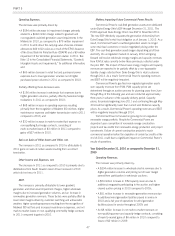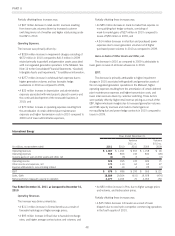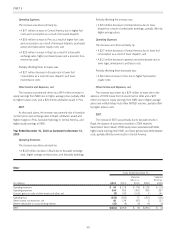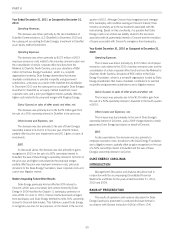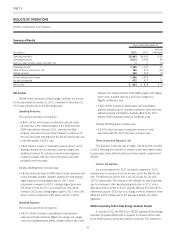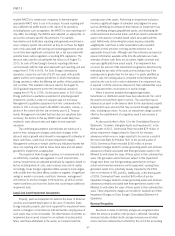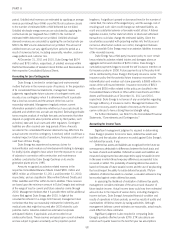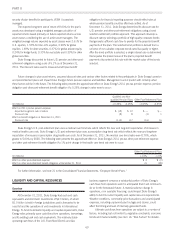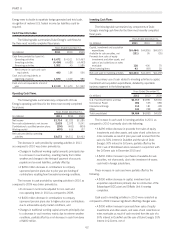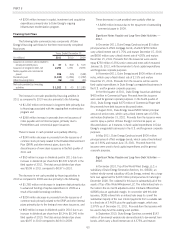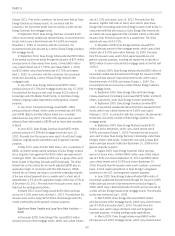Duke Energy 2011 Annual Report Download - page 75
Download and view the complete annual report
Please find page 75 of the 2011 Duke Energy annual report below. You can navigate through the pages in the report by either clicking on the pages listed below, or by using the keyword search tool below to find specific information within the annual report.
PART II
and the pending IGCC Rider proceedings are expected no sooner
than the end of the third quarter 2012. Duke Energy Indiana is
unabletopredicttheultimateoutcomeoftheseproceedings.Inthe
event the IURC disallows a portion of the plant costs, including
financing costs, or if cost estimates for the plant increase, additional
charges to expense, which could be material, could occur.
CRITICAL ACCOUNTING POLICIES AND ESTIMATES
The application of accounting policies and estimates is an
important process that continues to develop as Duke Energy’s
operations change and accounting guidance evolves. Duke Energy
has identified a number of critical accounting policies and estimates
that require the use of significant estimates and judgments.
Management bases its estimates and judgments on historical
experience and on other various assumptions that it believes are
reasonable at the time of application. The estimates and judgments
may change as time passes and more information about Duke
Energy’s environment becomes available. If estimates and judgments
are different than the actual amounts recorded, adjustments are
made in subsequent periods to take into consideration the new
information. Duke Energy discusses its critical accounting policies
and estimates and other significant accounting policies with senior
members of management and the audit committee, as appropriate.
Duke Energy’s critical accounting policies and estimates are
discussed below.
Regulatory Accounting
Duke Energy’s regulated operations (the substantial majority of
U.S. Franchised Electric and Gas’s operations) meet the criteria for
application of regulatory accounting treatment. As a result, Duke
Energy records assets and liabilities that result from the regulated
ratemaking process that would not be recorded under GAAP in the
U.S. for non-regulated entities. Regulatory assets generally represent
incurred costs that have been deferred because such costs are
probable of future recovery in customer rates. Regulatory liabilities
generally represent obligations to make refunds to customers for
previous collections for costs that either are not likely to or have yet to
be incurred. Management continually assesses whether the
regulatory assets are probable of future recovery by considering
factors such as applicable regulatory environment changes, historical
regulatory treatment for similar costs in Duke Energy’s jurisdictions,
recent rate orders to other regulated entities, and the status of any
pending or potential deregulation legislation. Based on this continual
assessment, management believes the existing regulatory assets are
probable of recovery. This assessment reflects the current political
and regulatory climate at the state and federal levels, and is subject to
change in the future. If future recovery of costs ceases to be probable,
the asset write-offs would be required to be recognized in operating
income. Additionally, the regulatory agencies can provide flexibility in
the manner and timing of the depreciation of property, plant and
equipment, recognition of nuclear decommissioning costs and
amortization of regulatory assets or may disallow recovery of all or a
portion of certain assets. Total regulatory assets were $4,046 million
as of December 31, 2011, and $3,390 million as of December 31,
2010. Total regulatory liabilities were $3,006 million as of
December 31, 2011 and $3,155 million as of December 31, 2010.
For further information, see Note 4 to the Consolidated Financial
Statements, “Regulatory Matters.”
In order to apply regulatory accounting treatment and record
regulatory assets and liabilities, certain criteria must be met. In
determining whether the criteria are met for its operations,
management makes significant judgments, including determining
whether revenue rates for services provided to customers are subject
to approval by an independent, third-party regulator, whether the
regulated rates are designed to recover specific costs of providing the
regulated service, and a determination of whether, in view of the
demand for the regulated services and the level of competition, it is
reasonable to assume that rates set at levels that will recover the
operations’ costs can be charged to and collected from customers.
This final criterion requires consideration of anticipated changes in
levels of demand or competition, direct and indirect, during the
recovery period for any capitalized costs.
The regulatory accounting rules require recognition of a loss if it
becomes probable that part of the cost of a plant under construction
or a recently completed plant will be disallowed for ratemaking
purposes and a reasonable estimate of the amount of the
disallowance can be made. Such assessments can require significant
judgment by management regarding matters such as the ultimate
cost of a plant under construction, regulatory recovery implications,
etc. As discussed in Note 4, “Regulatory Matters,” during 2011 and
2010 Duke Energy Indiana recorded disallowance charges of $222
million and $44 million, respectively, related to the IGCC plant
currently under construction in Edwardsport, Indiana. Management
will continue to assess matters as the construction of the plant and
the related regulatory proceedings continue, and further charges
could be required in 2012 or beyond.
As discussed further in Note 1, “Summary of Significant
Accounting Policies”, and Note 4, “Regulatory Matters,” Duke Energy
Ohio discontinued the application of regulatory accounting treatment
to portions of its generation operations in November 2011 in
conjunction with the approval of its new Electric Security Plan by the
Public Utilities Commission of Ohio. The effect of this change was
immaterial to the financial statements.
Goodwill Impairment Assessments
Duke Energy’s goodwill balances are included in the following
table.
December 31,
(in millions) 2011 2010
U.S. Franchised Electric and Gas $3,483 $3,483
Commercial Power 69 69
International Energy 297 306
Total Duke Energy goodwill $3,849 $3,858
The majority of Duke Energy’s goodwill relates to the acquisition
of Cinergy in April 2006, whose assets are primarily included in the
U.S. Franchised Electric and Gas and Commercial Power segments.
Commercial Power also has $69 million of goodwill that resulted
from the September 2008 acquisition of Catamount Energy
Corporation, a leading wind power company located in Rutland,
55




